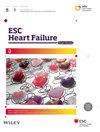Real-world use of guideline-directed therapy for heart failure: Insights from the Danish Heart Failure Registry
Abstract
Aims
We aimed to assess real-world implementation of guideline-directed medical therapy (GDMT) for heart failure (HF) with reduced ejection fraction (HFrEF) and its association with mortality and hospitalization.
Methods
We analysed 46 816 incident HFrEF patients from the Danish Heart Failure Registry (2008–2022). We examined the utilization of GDMT—renin–angiotensin system inhibitors (RASi), beta-blockers, mineralocorticoid receptor antagonists (MRAs) and sodium-glucose cotransporter-2 inhibitors (SGLT2i)—at 4, 8 and 12 weeks of follow-up according to the European Society of Cardiology guidelines within the intervals 2008–2011, 2012–2015, 2016–2020 and 2021–2022. Using Cox regression, we assessed the associations between GDMTs [none (reference), 1–2 GDMTs, and 3–4 GDMTs] initiated at 4, 8 and 12 weeks and 1 and 3 year mortality (all-cause and cardiovascular) and hospitalization (all-cause and HF).
Results
Between 2008–2011 and 2021–2022, RASi utilization at 4 weeks of follow-up was 93.2% and 93.7%, respectively, and at 12 weeks of follow-up, 97.2% and 97.8%, respectively. Beta-blocker use was 81.1% and 78.2% at 4 weeks and 89.6% and 90.4% at 12 weeks of follow-up while MRA utilization was 27.2% and 34.6% at 4 weeks and 32.6% and 52.2% at 12 weeks of follow-up. The SGLT2i use at 4 weeks increased from 0.0% to 21.3%, and at 12 weeks of follow-up from 3.2% to 35.8% between 2016–2020 and 2021–2022. The initiation of GDMTs at 4 weeks of follow-up was associated with lower adjusted hazard ratios (HRs) [95% confidence intervals (CI)] for 1 year all-cause mortality [1–2 GDMTs: 0.73 (95% CI: 0.61–0.86), 3–4 GDMTs: 0.65 (95% CI: 0.55–0.78)], 3 year all-cause mortality [1–2 GDMTs: 0.75 (95% CI: 0.66–0.86); 3–4 GDMTs: 0.67 (95% CI: 0.59–0.76)] and 3 year cardiovascular mortality [1–2 GDMTs: 0.74 (95% CI: 0.62–0.89); 3–4 GDMTs: 0.72 (95% CI: 0.59–0.87)]. Lower adjusted HRs were also observed for 1 year all-cause hospitalization [1–2 GDMTs: 0.80 (95% CI: 0.75–0.86); 3–4 GDMTs: 0.78 (95% CI: 0.73–0.84)] and 3 year all-cause hospitalization [1–2 GDMTs: 0.77 (95% CI: 0.72–0.83); 3–4 GDMTs: 0.77 (95% CI: 0.71–0.82)].
Conclusions
We demonstrated high use of RASi and beta-blockers and rising use of MRA and SGLT2i, reflecting rapid adaption to guidelines changes in incident HFrEF patients. Early GDMT initiation was associated with lower 1 and 3 year mortality and all-cause hospitalization. Upfront treatment with GDMT, according to the latest guidelines, is crucial.


 求助内容:
求助内容: 应助结果提醒方式:
应助结果提醒方式:


